
STOMPer Omg was surprised to find a small snake at an HDB staircase in Woodlands and wondered how it got there.There's nothing really surprising about finding snakes, even in urban neighbourhoods. After all, many species, such as the common wolf snake (Lycodon capucinus), reticulated python (Broghammerus reticulatus) and equatorial spitting cobra (Naja sumatrana) are highly adaptable and capable of living amongst people. If the housing estate is situated close to a park or an area of forest, there's an even higher likelihood of encountering even more snake species.
Said the STOMPer:
"This dying snake was found at Woodlands HDB staircase.
"How did this get here?!
The snake depicted in the photo appears to be a striped kukri snake (Oligodon octolineatus), a species said to be fairly common, not just in forests and scrubland, but also in gardens.
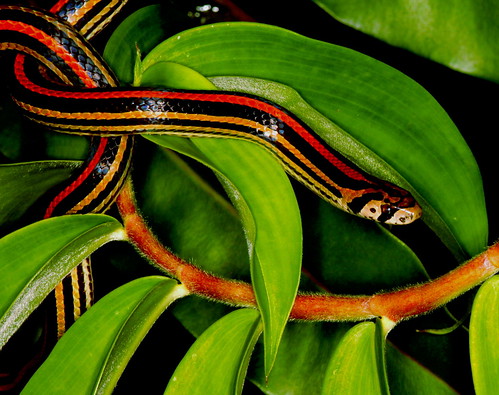
(Photo by Anne Devan-Song)
This is quite a small snake, with the longest individuals recorded at a mere 68 centimetres.
Besides the striped kukri snake, there are 2 other species of kukri snake found in Singapore, though these are rarer and restricted to the forests of the Central Nature Reserves.

(Photo by Wibowo Djatmiko)
The brown kukri snake (Oligodon purpurascens) comes in 2 distinct colour forms, one that is brown, as pictured above, and another morph that is a striking red. It's somewhat larger than the striped kukri snake, growing up to 98 centimetres;

(Photo by Johan van Rooijen, from Amphibians & Reptiles of Peninsular Malaysia)

The barred kukri snake (Oligodon signatus) is the rarest of the 3 species, both in Singapore and in Peninsular Malaysia;
(Photo by Nature Malaysia)
The kukri snakes are widespread across much of Asia, and get their name from their enlarged teeth, which are apparently shaped like the kukri, a curved Nepalese knife carried by Gurkhas.
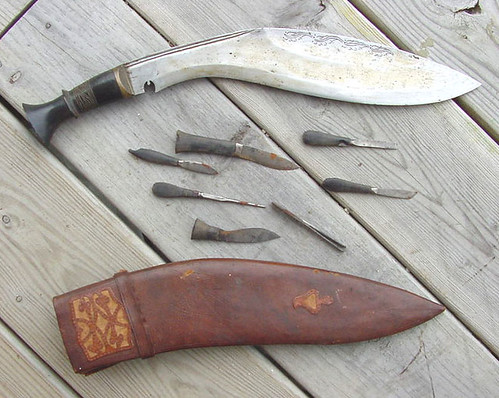
(Photo by wrcook)

Captive banded kukri snake (Oligodon fasciolatus) feeding. Note the large teeth;
(Photo from Venomdoc Forums)
These teeth are used to slit open reptile and bird eggs, which form the bulk of the diet of kukri snakes, although they will also prey on lizards, frogs, and rodents. Unlike other snake species which specialise on eggs, a kukri snake does not swallow the egg whole, but uses its teeth to slice a hole in the shell before sticking its head inside and swallowing the yolk. The teeth also enable the kukri snake to prey upon skinks; these lizards are typically covered in smooth and hard scales, and such teeth allows the snake to get a firm grip on its prey. They are semi-fossorial, which means that they spend a lot of time burrowing and living underground.
Formerly thought to be non-venomous, it has turned out that kukri snakes do possess a venom gland. The venom is too weak to have any serious effects on humans, though it may cause pain, localised swelling, and prolonged bleeding. The bulk of the damage comes from the teeth, which can inflict slashing wounds on soft human tissues, creating a bloody mess. Even leather gloves are apparently useless, and a bite from kukri snake may leave scars that last for years.

This is what happens when you get bitten by a kukri snake;
(Photo by Huang Wen-San, from Not Exactly Rocket Science)
When threatened, kukri snakes often raise and wave their tails about, exposing the often brightly-coloured underside. This is possibly to distract the predator and divert attention from the more vulnerable head. Should the threat go for the tail, this gives the snake the opportunity to strike in self-defence.

Taiwan kukri snake (Oligodon formosanus);
(Photo by Kevin Messenger)
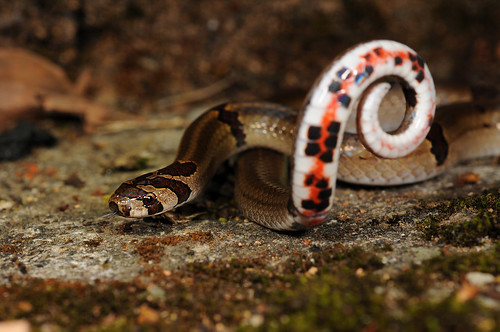
Ornate kukri snake (Oligodon ornatus);
(Photo by S k i n k)
This tendency to wave the tail may also be a form of mimicry; for instance, the highly venomous banded Malayan coral snake (Calliophis intestinalis) will respond to a threat by flipping itself over and exposing its strikingly patterned underside.


Banded Malayan coral snake;
(Photos by Gijs Damen)

Not to mention that the striped kukri snake, with its red dorsal stripe and black markings, does actually bear a superficial resemblance to the coral snake;
(Photo by Shirley Ng, from Life's Indulgences)
In some extreme cases, when caught, male kukri snakes are known to extrude their hemipenes (the equivalent of the penis in snakes and lizards), though whether this has any defensive purpose, or is simply a fear response, remains to be seen.

Banded kukri snake displaying its (bright pink) hemipenes;
(Photo by Wolfgang Wüster, from CalPhotos)
Interestingly enough, a population of kukri snakes is unique in being territorial. On Orchid Island near Taiwan, green turtles (Chelonia mydas) haul up onto the beaches to nest, laying up to a hundred eggs, which are buried and then abandoned. This massive, unguarded stockpile of food presents an irresistible food source for the resident Taiwanese kukri snakes, which invade the nests and feast for up to 2 months before the eggs hatch.
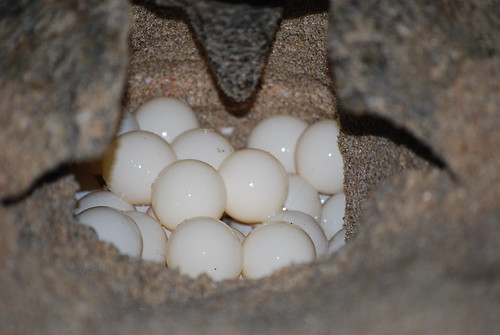
Green turtle laying eggs. For a snake that specialises on eggs, this is a real feast;
(Photo by LIVING_BY_THE_MOMENT)
Naturally, such larders are worth defending from rivals. Should more than one snake enter a turtle nest, fights may ensue. With their sharp teeth, the kukri snakes can deal serious damage to one another, and given that the tail is often employed to distract attackers, it is this part of the body that bears many of the injuries from these battles. And because the hemipenes are often revealed during these encounters, the males tend to have a disadvantage; after all, you can't sire any more young if your genitals were injured or bitten off. As for females, even if she loses part of her tail, her ability to reproduce is unimpeded. And so, the males are more likely to concede ownership of the turtle nests to the females.

Taiwanese kukri snake;
(Photo by cowyeow)
This is reflected in the behaviour shown by the different sexes. When male Taiwanese kukri snakes find a turtle nest, they eat as much as they can and move on. Females, on the other hand, will enter the nest and guard it fiercely. If she finds a male already inside, she will forcibly evict him, even though males are generally larger. If another snake subsequently arrives at the nest she is defending, the newcomer has a higher chance of being able to stay and share the spoils if it's a female; males tend to leave in a hurry, often with fresh wounds on their tails. It's a unique combination among snakes of having an abundant, immobile, and long-lasting supply of food, with the right weapons to defend this resource. As noted in the study, "Unusual circumstances thus have favored this surprising evolution of territorial behavior, such that only females can defend a long-lasting and abundant supply of food with little additional cost."
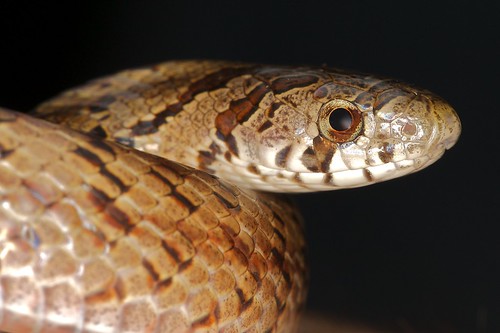
Taiwanese kukri snake;
(Photo by robferblue)
It's fascinating to see what sort of wildlife one may encounter, even in the heartlands. One can only hope that more people will learn to leave these snakes alone, or at least contact the Animal Concerns Research and Education Society (ACRES) Wildlife Rescue to safely capture and relocate them.